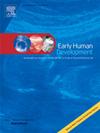注意缺陷多动障碍患儿母亲的2D:4D比值。
IF 2
3区 医学
Q2 OBSTETRICS & GYNECOLOGY
引用次数: 0
摘要
背景:产前暴露于高水平的睾丸激素会影响大脑的发育。本研究的目的是比较注意缺陷多动障碍(ADHD)儿童的母亲与健康儿童的母亲在手指比例(2D:4D)方面的差异。它还研究了ADHD症状与母亲的2D:4D之间的关系。方法:选取120例ADHD患儿的母亲和61例健康儿童的母亲作为研究对象。测量患者和健康个体的2D:4D,并检查社会人口学数据。使用成人ADHD自我报告量表(ASRS)测量母亲的ADHD症状。比较患者和对照组的2D:4D值和ADHD症状。在患者组中也检测了2D:4D与ADHD的关系。结论:我们的发现增加了有关产前暴露于睾酮与ADHD之间关系的文献。这项研究表明,患有多动症的孩子的母亲在产前接触到更多的睾丸激素。此外,它也不支持ADHD儿童母亲产前暴露于睾丸激素与ADHD症状发展有关的假设。现在需要进一步研究母亲之间的这种关系。本文章由计算机程序翻译,如有差异,请以英文原文为准。
The 2D:4D ratios in the mothers of children with attention deficit hyperactivity disorder
Background
Prenatal exposure to high levels of testosterone affects the development of the brain. The purpose of this study was to compare the mothers of children with attention deficit hyperactivity disorder (ADHD) and those of healthy children in terms of the digit ratio (2D:4D). It also examines the relationship between ADHD symptoms and the 2D:4D in mothers.
Method
The mothers of 120 children with ADHD and of 61 healthy children were included in the study. 2D:4D were measured for both the patients and the healthy individuals, and sociodemographic data were examined. The mothers' ADHD symptoms were measured using the Adult ADHD Self-Report Scale (ASRS). The patient and control groups were compared in terms of 2D:4D values and ADHD symptoms. The relationship between 2D:4D and ADHD was also examined in the patient group.
Results
Maternal right 2D:4D (p < 0.001) and left 2D:4D (p = 0.003) values in the ADHD group were significantly lower than in the control group mothers. No association was also observed between the left hand and right 2D:4D ratios of the mothers in the case group and the ASRS- Hyperactivity or Attention Deficit subscales.
Conclusion
Our findings add to the literature examining the relationship between prenatal exposure to testosterone and ADHD. This study shows that the mothers of children with ADHD are exposed to greater prenatal testosterone. In addition, it does not support the hypothesis that prenatal exposure to testosterone in the mothers of children with ADHD plays a role in the development of ADHD symptoms. Further studies examining this relationship in mothers are now needed.
求助全文
通过发布文献求助,成功后即可免费获取论文全文。
去求助
来源期刊

Early human development
医学-妇产科学
CiteScore
4.40
自引率
4.00%
发文量
100
审稿时长
46 days
期刊介绍:
Established as an authoritative, highly cited voice on early human development, Early Human Development provides a unique opportunity for researchers and clinicians to bridge the communication gap between disciplines. Creating a forum for the productive exchange of ideas concerning early human growth and development, the journal publishes original research and clinical papers with particular emphasis on the continuum between fetal life and the perinatal period; aspects of postnatal growth influenced by early events; and the safeguarding of the quality of human survival.
The first comprehensive and interdisciplinary journal in this area of growing importance, Early Human Development offers pertinent contributions to the following subject areas:
Fetology; perinatology; pediatrics; growth and development; obstetrics; reproduction and fertility; epidemiology; behavioural sciences; nutrition and metabolism; teratology; neurology; brain biology; developmental psychology and screening.
 求助内容:
求助内容: 应助结果提醒方式:
应助结果提醒方式:


